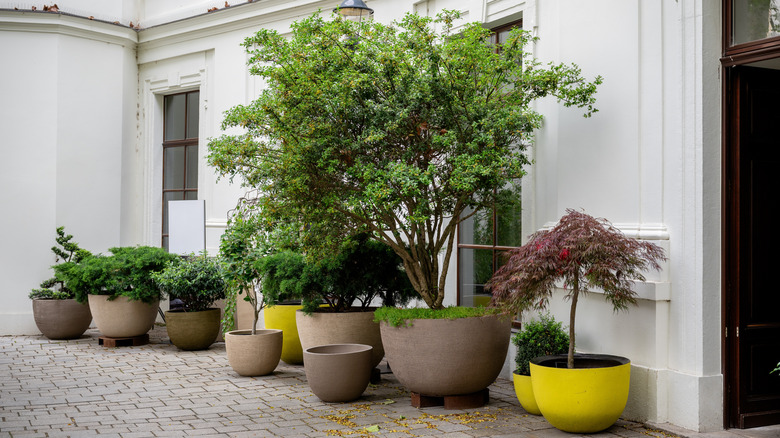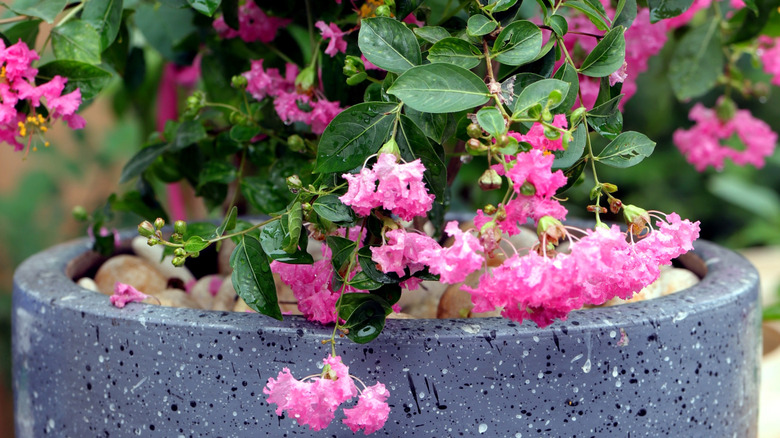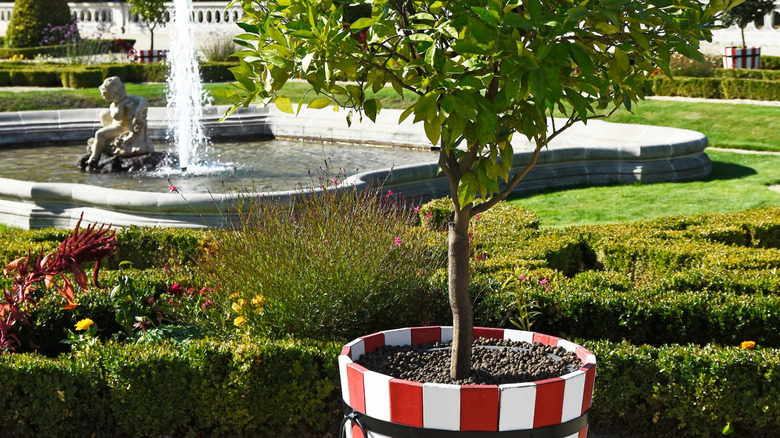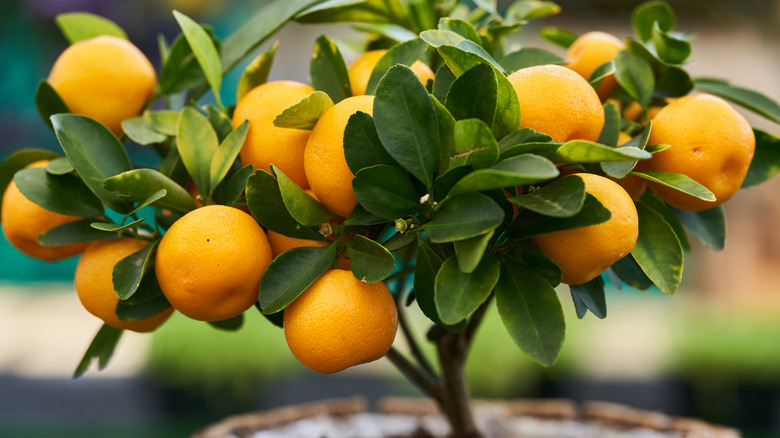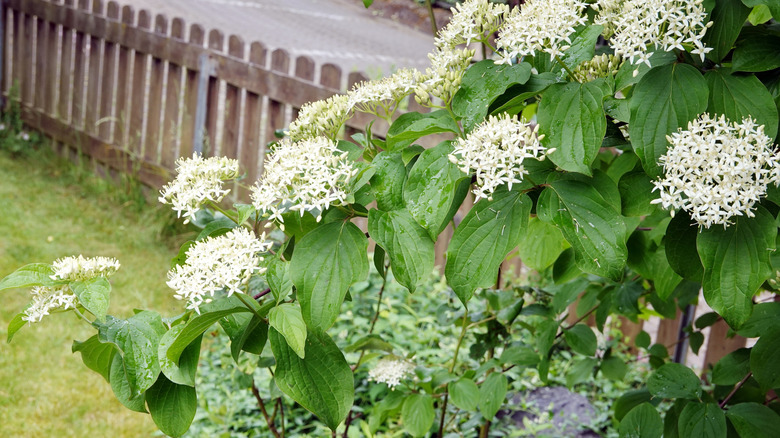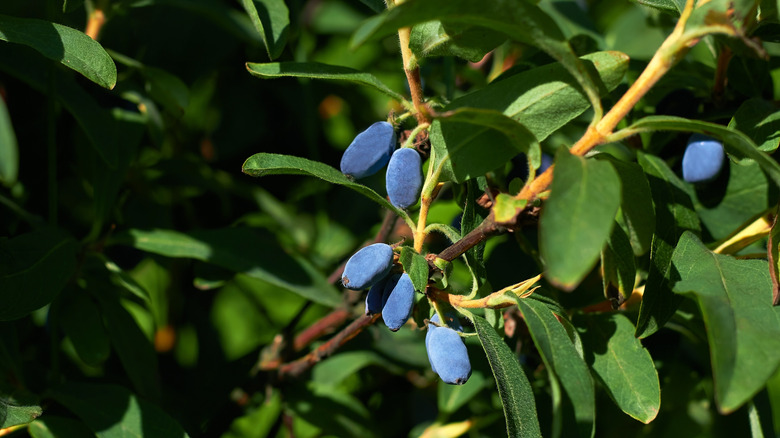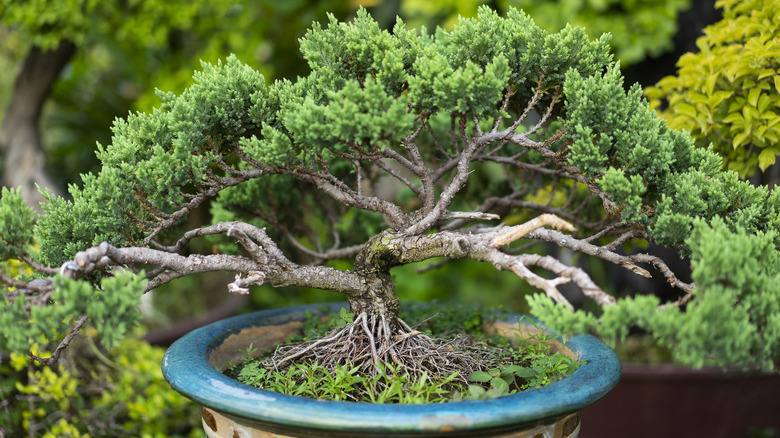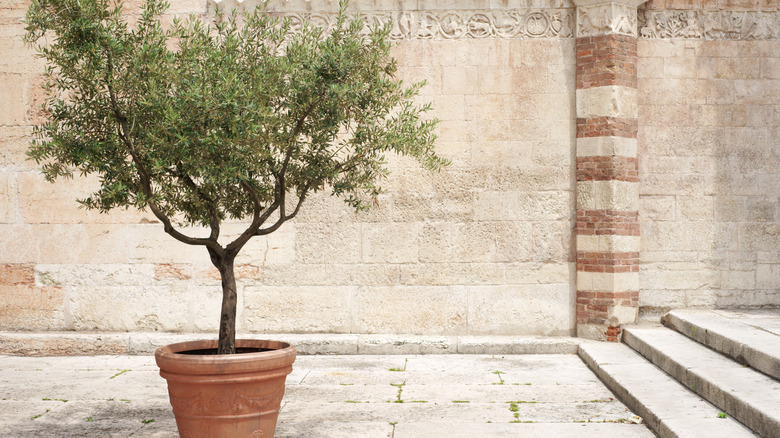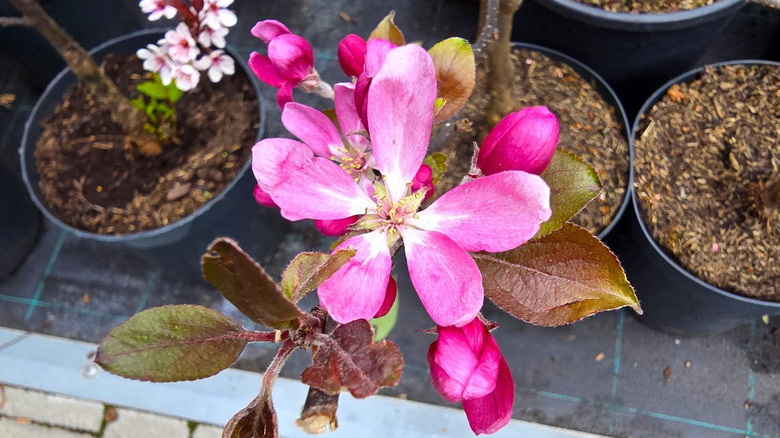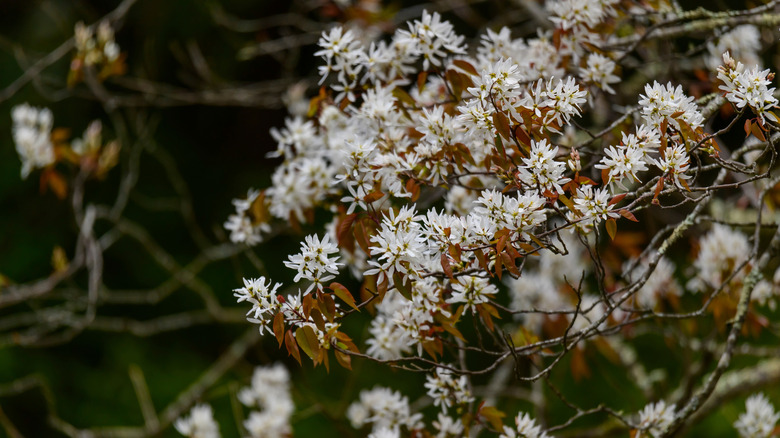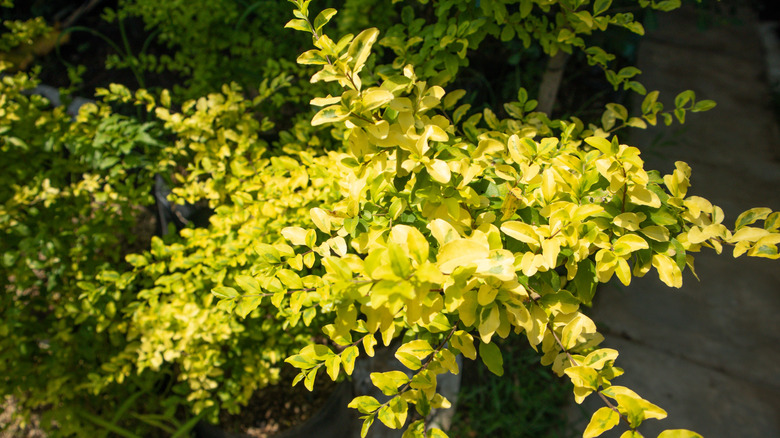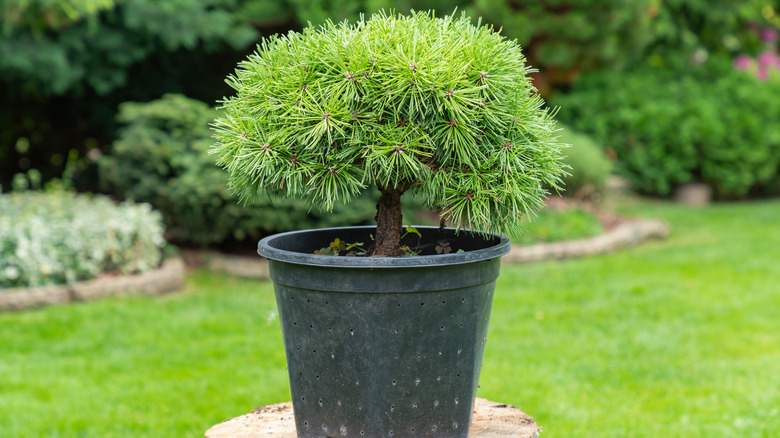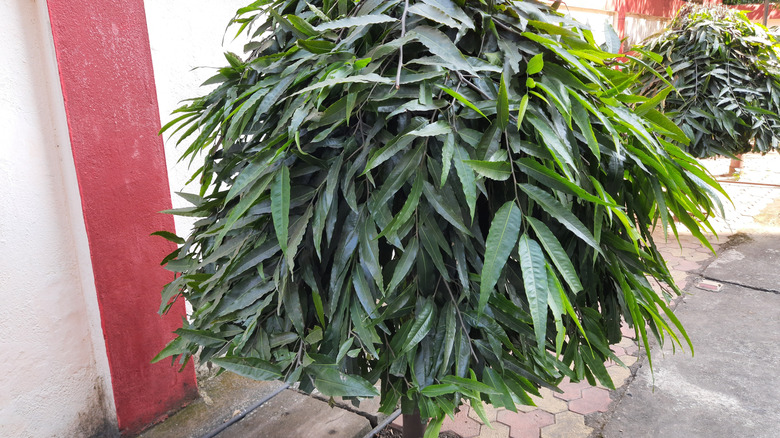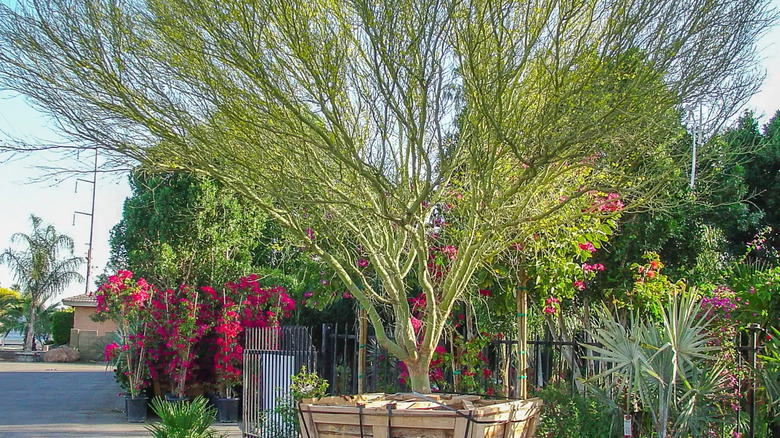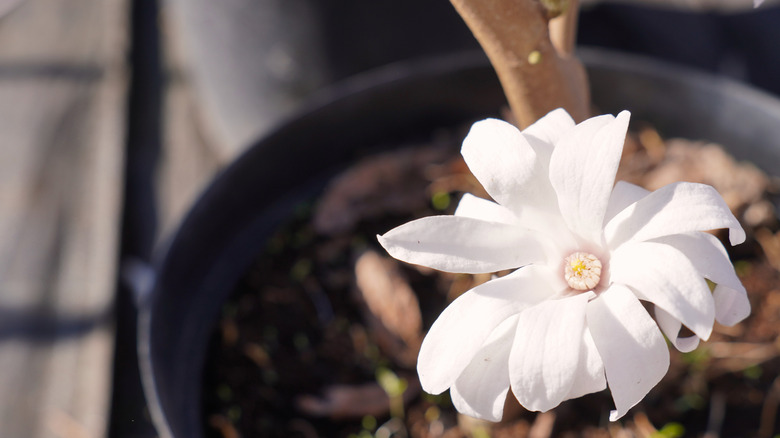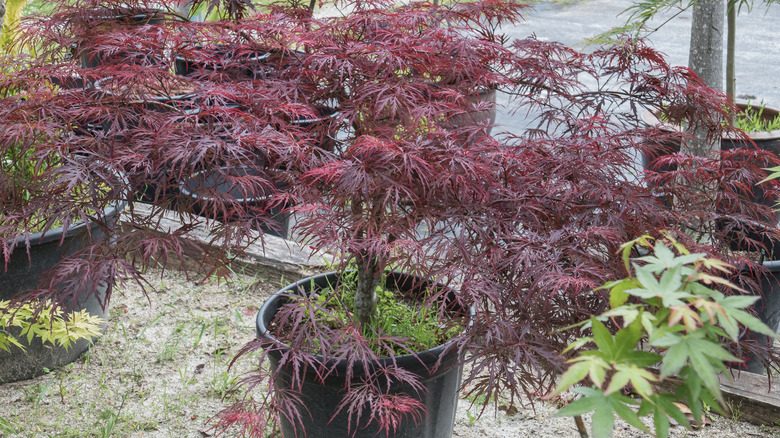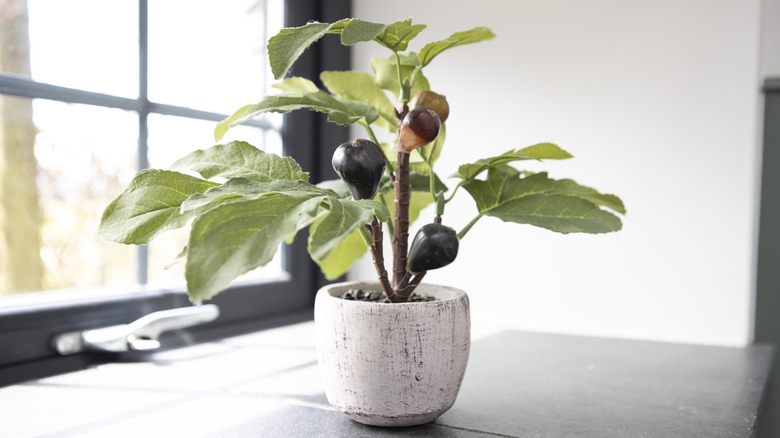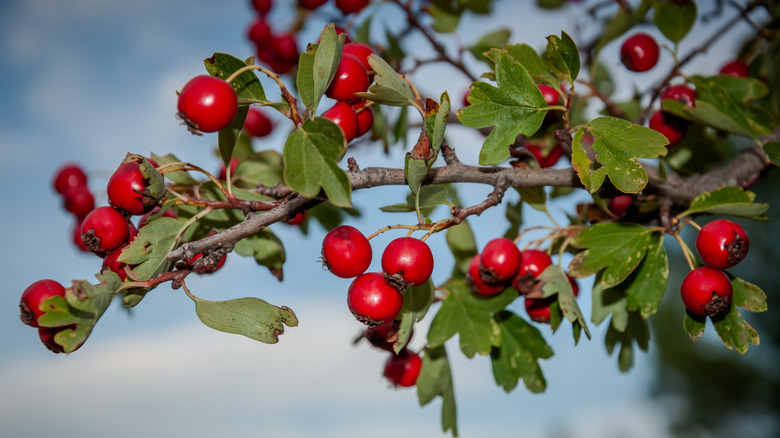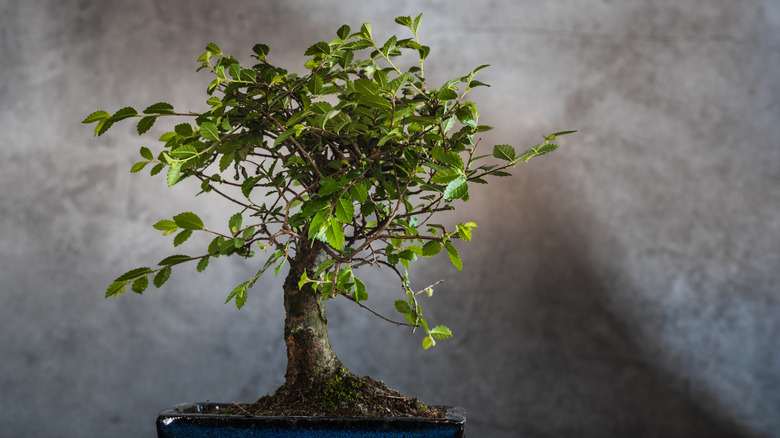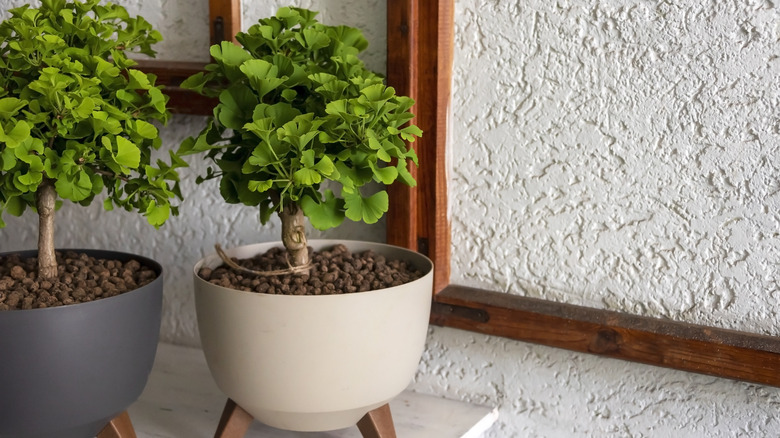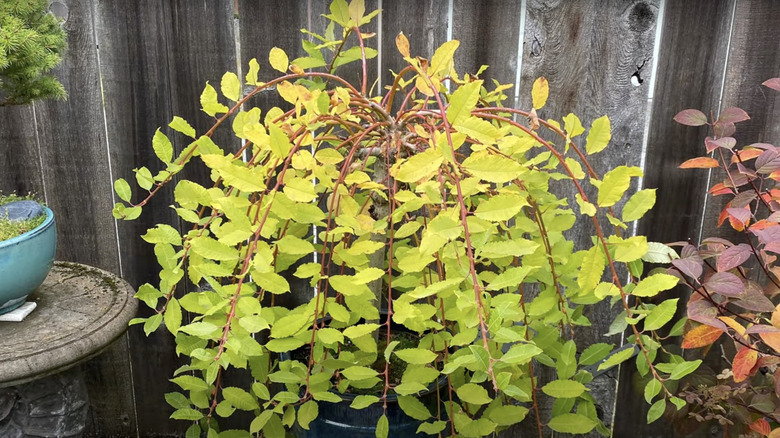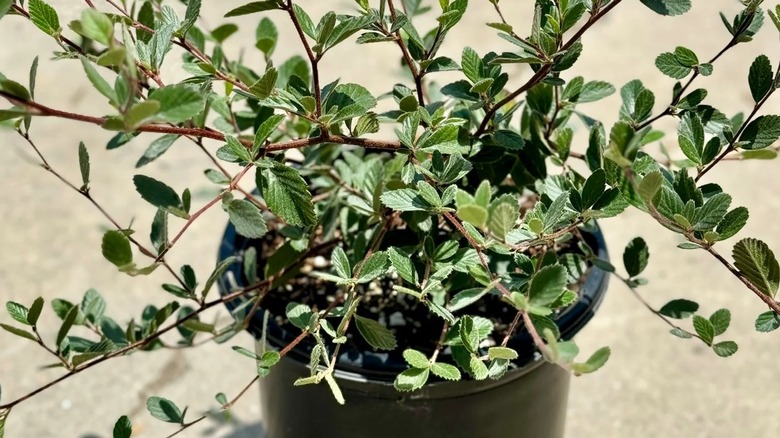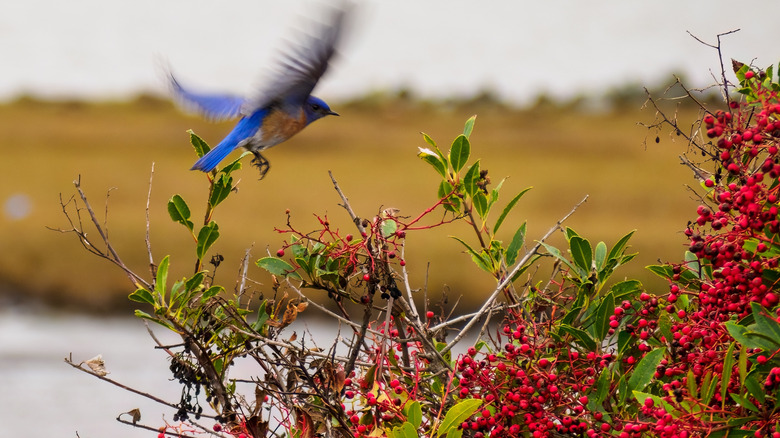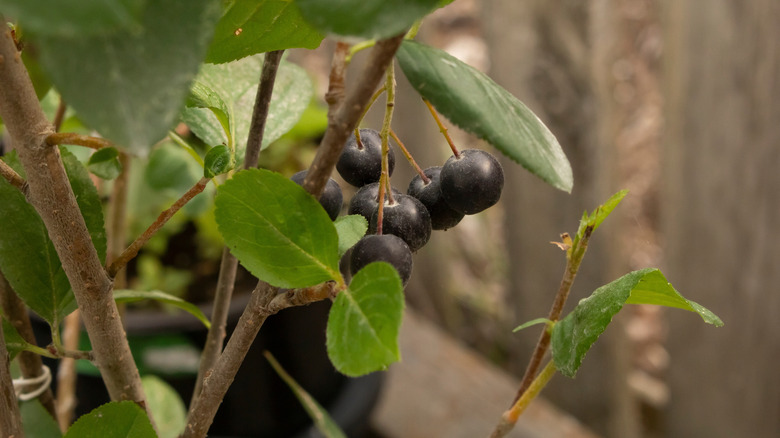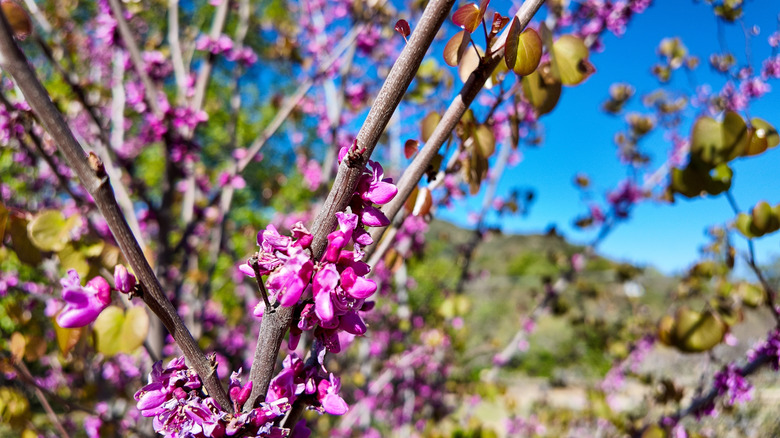27 Varieties Of Trees That Grow Happily In Garden Containers
We may receive a commission on purchases made from links.
Given the height the word tree implies, you'd be forgiven for questioning whether there's such a thing as container gardening for trees. And indeed, many of these giants of the plant world simply aren't suited to life in the cramped confines of a planter — no matter how big it is. There are some diminutive trees, those that stay under 10 feet or so, that thrive in a container — think Japanese maples and native witch hazels. There are also lots of dwarf varieties, larger tree species bred by nurseries to grow and stay small. Examples include ruby blooming Lagerstroemia indica 'Tightwad Red' and the gold-leaved Ginkgo biloba 'Mariken'. Then, of course, there are specialist techniques like bonsai from Japan that aid gardeners in keeping trees teeny. Often, these well-cared-for plants grow into living works of art, with some even outlasting their owners.
Growing tall woody plants in containers requires a few more techniques than just digging a hole in the ground and plonking them inside. Pots need to be big enough to accommodate the root system of the plant when mature; this may require some research on your part. Tall, narrow containers are better suited to growing small trees than short, wide planters. However, check periodically for girdling — where the roots wrap around one another, eventually cutting off the supply of nutrients and water. If you live in cold climes and want your teeny potted trees to survive, you'll need to consider how much free space you have inside your house or garage to overwinter them.
A crape myrtle adds a burst of color to your container garden
Crape myrtles fall under the genus Lagerstroemia and boast lots of attractive features, from large flower clusters in soft or dramatic hues to bright fall leaves and interesting shedding bark that adds to the trees' ornamentation rather than deflecting from it. If you've decided you'll grow crepe myrtle trees in containers to add show-stopping beauty to your patio, make sure you look for dwarf varieties, which grow to heights of around 4 feet. Try ruby-blooming Lagerstroemia indica 'Tightwad Red', white-flowering 'Acoma', or the pretty pink-purple 'Mauve Dwarf'.
The bountiful bay tree is useful in a container kitchen garden
You've probably used bay leaves in cooking, but did you know this Mediterranean tree thrives in Hardiness Zones 8b to 10b? The bay tree or bay laurel (Laurus nobilis) is a hardy choice for southern gardens, though the plant can tolerate a few hard freezes. Expect your potted bay to reach around 9 feet at maturity. Trim the tree down a few feet or into topiary shapes if that feels too tall. If you prefer local natives, the lookalike California bay laurel (Umbellularia californica) also does well in containers.
A zesty potted calamondin provides a pop of orange
Calamondin (Citrofortunella microcarpa, synonymous with Citrus × microcarpa), also known as calamansi, is a Philippine native orange tree variety that's great for growing in containers and small spaces. It's mostly grown as a small ornamental tree or patio plant here in the States. Its fragrant flowers and teeny edible fruit make it an attractive choice. It's definitely a container plant — in fact, a pot is non-negotiable for any gardener growing below Zone 10. For something a little bit different, consider the Citrofortunella microcarpa cultivar 'Peters', which boasts attractive variegated leaves.
Complement your potted patio garden with dramatic dogwood trees
Show off stunning dogwood trees with a unique way of planting them: in a container on your patio. With 30 to 60 species in the Cornus genus, there are many dogwood trees to choose from. Native flowering dogwood (Cornus florida) is most commonly grown; the tree thrives in Zones 5 through 9 and boasts fluffy white flower clusters followed by bird-attracting red berries. Other popular options include pagoda dogwood (Cornus alternifolia) and the vibrant red twig dogwood (Cornus alba or stolonifera cultivars). Avoid the now-invasive kousa dogwood (Cornus kousa).
Honeyberry is a hardy and long-lived container tree
Honeyberry (Lonicera caerulea) is a heat- and cold-tolerant fruit tree you can grow in a compact container. This honeysuckle relative reaches 6 feet tall at most, making it ideal for potted life, and features edible fruit that resembles long blueberries. This ultra-cold hardy plant needs low temperatures to produce lots of berries, so it's best for container gardeners in Hardiness Zones 1 to 8. The tree will live for decades if properly cared for. You can get a 4 to 6 inch tall HILROQG Live Honeyberry Bare Root Plant for about $37.
Bring some living art to your container garden with bonsai trees
Bonsai, Japanese for "planted in a tray," isn't just about growing teeny trees. It's a distillation of nature. Most trees and shrubs can be made miniature, and the best type of pot for a happy and healthy bonsai tree is something that complements its characteristics. A rustic Wazakura Shigaraki Series Handmade Leaf-Shaped Ceramic Bonsai Pot for about $50 is perfect for dense and dramatic tree species, while dainty flowering shrubs are better suited to this set of two HUOMUSIR 10 Inch Blue Glaze Shallow Bonsai Pots for about $35.
Olive trees are an ancient (and easy to grow) container garden plant
Humans have been cultivating olive trees (Olea europaea) for at least 6,000 years, with the Eastern Mediterranean the likely point of origin. Most cultivars thrive in pots, including dwarf varieties like the Olea europaea 'Montra', also frequently referred to as Little Ollie. If you want to harvest olives, go for the large-fruiting Picual variety from Spain. They're also cold-hardy. Olive trees don't like wet feet, so choose a container with lots of drainage holes and use a cactus and succulent potting mix.
Consider a crabapple for your next container arrangement thriller
Crabapples (Malus species) regularly top lists of hardy trees for containers. Most cultivars are drought and cold tolerant. The fruit they produce is small and tart, but definitely edible for both humans and the critters that visit your patio garden. If a wildlife-friendly backyard is your aim, consider the North American native species sweet crabapple (Malus coronaria), Pacific crabapple (Malus fusca), and small statured prairie crabapple (Malus ioensis). For dramatic fall color, consider the red-hued Prairiefire flowering crabapple (Malus 'Prairifire'). Dwarf tree Lancelot flowering crabapple (Malus × 'Lanzam') has golden-hued fruit.
Create a sensory container garden with a fragrant frangipani
If there isn't already an adage stating to plant your plumeria tree in a container and it'll be living its best life, there should be. These unusual plants — with their stocky, succulent-like limbs and long, fleshy leaves — not only lend a tropical vibe to any patio they're placed on, but deliver a scent worthy of a master perfumer. They can only grow outdoors year-round in Zones 10 to 11, so be prepared to overwinter your frangipani (the other common name for this tree) if you experience frosts.
Plant a downy serviceberry in a pot for year-round attraction
Going native with your container garden is always a good move for wildlife, and the downy serviceberry (Amelanchier arborea) in particular has special value for native bees. What's more, it's a nice plant to look at year-round, with snowy white blooms, scaling bark, and red fall leaves. While these trees can reach up to 40 feet in nature, they'll top out between 15 and 25 in cultivation. You'll likely need to repot your serviceberry into a larger container every few years until it reaches its mature height.
Showy blackhaw is a native tree that thrives in planters
While blackhaw (Viburnum prunifolium) is technically a sucker-forming native shrub, it can easily be trained into tree form when planted in a pot. Prune off any lateral branches and stake the stem straight using thick staking twine or old tights. Grow ultra-hardy blackhaw on your patio or deck for its puffs of white flowers in the spring and maroon leaves and edible fruit in the fall. It will eventually reach 15 feet in height, but grows slowly, giving you more than enough time in a pot.
Court the daylight with a potted sunshine ligustrum
While most Ligustrum species are highly invasive plants in North America, there's one type of Ligustrum tree that's perfect for growing in containers. Sunshine ligustrum (Ligustrum sinense 'Sunshine') is a sterile (flowerless) — and, thus, far more docile — cultivar of run-rampant Chinese privet. As a dwarf variety, it tops out at about 5 feet tall, making it easy to underplant with vibrant flowering annuals or trim into neat topiary shapes. It has yellow-green foliage all year round in Zones 6 through 10. Note, however, that it's toxic to humans, dogs, and cats.
The dinkiest conifers make easy-care additions to any container garden
These (mostly) evergreen trees provide year-round color and boast sculptural forms that add interest to a small backyard, patio, or balcony without the hassle of raking leaves. There are innumerable species of dwarf conifer to consider for your next planter project, from the blue-hued native Colorado bristlecone pine (Pinus aristata) and mahogany-leaved plume cryptomeria (Cryptomeria japonica 'Elegans') to the curvy weeping Blue Atlas cedar (Cedrus atlantica 'Glauca Pendula') and lime green-needled weeping European larch (Larix decidua 'Pendula') — among, of course, many, many others. Choose dwarf cultivars where possible.
Extra long leaves make a pot-planted mast tree stand out
The mast tree (Polyalthia longifolia) is an evergreen native to Asia with long, droopy, forest green leaves. They grow tall and slender rather than wide, making them the perfect solution for tight spaces. While mast trees do well in large planters, you'll eventually need to plant them in-ground. Earmark a spot in advance. They're also on the pricey side: five Wekiva Foliage Live Mast Trees in 4 Inch Growers Pots costs almost $120, so it's vital you learn how to care for a mast tree before bringing one home.
Have a xeriscape container garden? Add drought-hardy blue palo verde
Blue palo verde (Parkinsonia florida) is a Sonoran desert native tree — it's Arizona's official state tree, and is therefore highly adapted to surviving drought conditions. Outside of shedding its leaves when subjected to a severe lack of water, it also makes use of both its leaves, as other trees do, and bark to produce chlorophyll. Of all the palo verde, it's the first to flower as winter draws to an end. Make sure you buy the correct species; some Parkinsonia varieties, like Mexican palo verde (Parkinsonia aculeata), are invasive.
Go diminutive with magnificent magnolia trees for planters
Part of learning how to grow and care for magnolia trees destined for container gardners is understanding that some magnolia tree species grow very large. Look, instead, for dwarf varieties when growing this romantic plant in pots. Star magnolia (Magnolia stellata) is probably the most often recommended magnolia tree for container gardens. Other small-of-stature options include Little Gem magnolia (Magnolia grandiflora 'Little Gem'), a slow-growing dwarf offspring of the beloved southern magnolia, and Oyama magnolia (Magnolia seiboldii), which reaches 15 feet tall at most and thrives in Zones 6 to 8.
Few container trees beat Japanese maple for fall color
Japanese maple (Acer palmatum) is a gorgeous tree that will boost your home's value, pair well with ground covers in contrasting leaf hues in the same planter, and is cold-hardy in containers. The tree rarely exceeds 15 feet tall, with many varieties under that height, and their hand-shaped leaves turn shades of bright red to deep maroon come fall. Consider cultivars 'Crimson Queen' and 'Bloodgood' for pots on a patio or balcony. Other options for containers include the vine maple (Acer circinatum), Amur maple (Acer ginnala), and paperback maple (Acer griseum).
Pick native witch hazels for your container garden over introduced species
While there are a few species of witch hazel worldwide, we recommend growing one of the two North American native species, American witch hazel (Hamamelis virginiana) or Ozark witch hazel (Hamamelis vernalis). They're hardier than their introduced counterparts, thriving in Zones 5 through 8. Hamamelis virginiana has bright yellow flowers and lime green leaves that turn mustard in the fall. It will grow to 15 feet if well cared for. The Ozark species has distinctive burnt orange blossoms and is a little smaller, stopping at about 10 feet tall.
Figs: the food of the gods you can grow in a planter
One thing you should know before planting a fig (Ficus carica) is that these weedy looking trees do better in pots than they do in the ground. Figs, it turns out, like being a bit root bound. Buy a Wellspring Gardens Fignomenal Dwarf Fig Live Plant for a little under $22. Ficus carica is hardy down to Zone 7b, so they need protection from cold climates in the form of wraps or overwintering indoors. Keep in mind, too, that dropping fruit can make a mess of your patio.
Hardy hawthorn trees are an easy option for beginner container gardeners
Outside of classic holly, few plants have as festive of a vibe as hawthorn (Crataegus species). These rambling trees boast blooms loved by spring pollinators in various shades of white to pink along with red fall berries. They're generally a hardy container species. North Carolina native Washington hawthorn (Crataegus phaenopyrum) will, for example, grow in pretty much any soil, even heavy clay, and appears impervious to city smog. Just watch your hands and arms when you're pruning your potted hawthorn tree. The branches are covered in thorns.
Vase-shaped Japanese zelkova are excellent pot plants when young
Love elms but worried about the Dutch elm disease knocking them off? Japanese zelkova (Zelkova serrata) are in the elm family, but are impervious to this dreaded arbor illness. Plus, they make a great addition to a container garden when they're young and attractively vase shaped. They will evenly reach heights of 50 feet or more, so you'll need a decent sized patch of garden (or know someone who has) ready for later transplant. Grow this East Asian native tree in Zones 5 to 8 for their stunning fall color.
Grow a gorgeous dwarf ginkgo in a planter
Ginkgo (Ginkgo biloba) trees are fascinating; they've been on earth for so long, largely unchanged, that they're considered a living fossil by botanists. Their most popular feature is their unusual, fan-shaped leaves, which turn a brilliant gold in the fall. Get a Japanese Maples and Evergreens 5 Year Graft Ginkgo Biloba 'Mariken' for about $70, which grows to about 8 feet tall. Another diminutive cultivar, growing to about 6 feet tall, is Ginkgo biloba 'Chase Manhattan. Plant male trees if you can; the fruit of the female ginkgo has a putrid stench.
A container garden isn't complete without a weeping pussy willow
Weeping pussy willow (Salix caprea 'Pendula') is an 8-foot-tall tree with elongated spring flower clusters aptly called catkins that flow like a fountain out from the trunk. Developed by grower Thomas Lang in Scotland, the tree is hardy to Zone 4, making it a good option for container gardeners in chillier parts of the U.S. Prefer something a little larger? Desert willows (Chilopsis linearis) reach just 15 feet when mature (though others sprout to lofty heights at least twice that number), making them an alternative native willow for planters.
Birchleaf mountain mahogany is a must-have potted evergreen
Reaching heights of up to 15 feet when mature, birch-leaf mountain-mahogany (Cercocarpus montanus var. glaber) is an evergreen tree often recommended for container gardening, especially for home growers cultivating a low-maintenance backyard. It boasts a beautiful smooth gray trunk and leaves that resemble those of birch trees. Deer love to nibble on its tender leaves, but it recovers quickly. It's also drought and even fire resistant. If you're looking to buy one of these trees for your potted patio, you might find it listed under the synonym Cercocarpus betuloides at nurseries.
You'll have no trouble growing toyon in a container
Toyon (Heteromeles arbutifolia) is widely considered an native anchor or keystone plant with year-round value for wildlife and garden aesthetics. The bright red berries ripen in the dead of winter and it never loses its leaves. This evergreen tree will live happily at 6 to 8 feet tall with regular pruning; it loves full sun, but will tolerate dappled or part shade, too. If you have too many red berried trees in your potted collection, try Heteromeles arbutifolia 'Davis Gold', which boasts sunshine yellow fruit.
Easily prune a potted chokeberry shrub into a tree
The chokeberry (Aronia melanocarpa) is one of the many large-sized shrubs you can easily prune into a tree. In fact, some heavyhanded thinning makes the plant even more productive, giving you and your family (and any hungry wild critters that get to them) a ton of delicious berries to enjoy. Bonus: the shrub is native to the U.S. and there are cultivars with red and black berries. Ready to get planting? Pick up a Green Promise Farms Store Proven Winners White Flower Chokeberry Shrub for a bit under $50.
Rosy Western redbud: A container tree with many uses
Looking for a container garden tree that's also useful in your craft room? Western redbud (Cercis occidentalis) is prized by basket weavers for its pliable branches as much as it is beloved by gardeners for the rosy blooms that umbrella over trunk in spring. In summer, the tree has an abundance of blue-hued leaves that are equally useful in planting arrangements. Native to Utah, Arizona, and California, it will grow in Zones 6 and above and can live for over a century with the right care.
